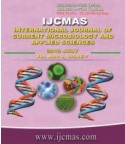


 National Academy of Agricultural Sciences (NAAS)
National Academy of Agricultural Sciences (NAAS)

|
PRINT ISSN : 2319-7692
Online ISSN : 2319-7706 Issues : 12 per year Publisher : Excellent Publishers Email : editorijcmas@gmail.com / submit@ijcmas.com Editor-in-chief: Dr.M.Prakash Index Copernicus ICV 2018: 95.39 NAAS RATING 2020: 5.38 |
Field experiments were conducted with hybrid brinjal under IPNS during 2017-18 adopting Inductive cum Targeted yield model (Ramamoorthy et al, 1967) to develop post-harvest soil test values (PHSTVs) prediction equations on Visakhapatnam soil series (TypicHaplustept) which is rednon-calcareous. The experiment was laid out in a fractional factorial design comprising twenty four treatments and the test crop experiment with hybrid brinjal was conducted with four levels of each of N (0, 80, 160 and 240 kg ha-1), P2O5 (0, 40, 80 and 120 kg ha-1) and (0, 60, 120 and 180 K2O kg ha-1) and three levels of FYM (0, 12.5 and 25 t ha-1). The IPNS treatments were superimposed across the strips. There were 21 fertiliser treatments along with three controls which were randomized in each strip in such a way that all the treatments occurred in both directions. Using the plot wise initial test values, fertiliser doses and fruit yield and /or uptake of N, P & K by brinjal and post-harvest soil test values, PHSTVs prediction equations were developed. Both the predicted and observed soil test values revealed that the soil fertility was found to decline markedly under unfertilized (control) and increased based on fertiliser doses imposed and soil fertility gradient. Significant R2 values were recorded for these regression equations which could be used with confidence for the prediction of post-harvest KMnO4-N, Olsen –P and NH4OAc-K. Using the predicted PHSTVs of hybrid brinjal soil test based fertiliser prescriptions for desired yield targets of any succeeding crop could be prescribed.
 |
 |
 |
 |
 |